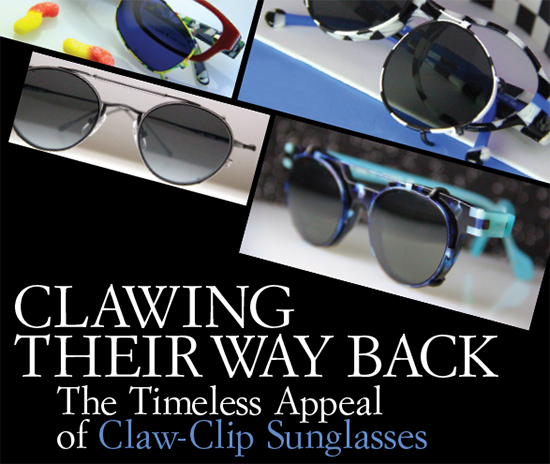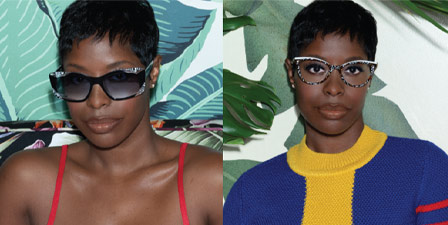
Clip Options: Arnold De’ Burdo’s CustomEyes is boundless in its quest to deliver sun clips that virtually claw their way into the DNA of any given frame. Every combination here speaks to that endless gallery of OPtions. Connect with him at (818) 502-0204 and [email protected].
By Preston Fassel
Sometimes you just gotta take form over function.
Take cars, for instance. Cold, hard data will tell you that my 2010 Smart Car is among the most efficient automobiles on the road. The gas mileage is superb, and barring particularly rare types of accidents, it’s got a solid safety record. Without any kids to tote around, the two seats are just enough for my wife and me, and there’s plenty of cargo space in the back for my dry cleaning and groceries. If someone were to offer me the choice between the Smart and a Dodge Charger, though… Well, bye-bye Smart. The Charger’s sleek. The Charger’s tough. The Charger’s cool. For all of its economic vitality and eccentric charm, the Smart can’t beat the classic, hardcore elegance of the Charger.
And sometimes, the same goes for glasses.
 Plenty of manufacturers have perfected the magnetic clip-on, as efficient a means of attaching a pair of sun shades to your ophthalmic glasses as possible. Snap on, snap off… problem solved. The lenses won’t get scratched, the clip won’t come off. Compare the magnetic variety of clip-ons to the classic claw-grip though, and it’s hard to argue that something hasn’t been lost. The magnetic clip is sleek, yes, and streamlined, attaching to the frame with a clean, efficient resiliency that almost completely masks that they’re clips at all… But where’s the fun in that? There’s something to be said for a certain degree of ruggedness. Old-school clips arose out of a need for functionality; they’re the optical equivalent of the sharpened stick, the Model T. Worried they’ll scratch your lenses? Then be careful with them; you shouldn’t be whipping your frames off with one hand, either. Or leaving them in the car during summer. Or sleeping in them. Yeah, that’s right. I’m talking to YOU.
Plenty of manufacturers have perfected the magnetic clip-on, as efficient a means of attaching a pair of sun shades to your ophthalmic glasses as possible. Snap on, snap off… problem solved. The lenses won’t get scratched, the clip won’t come off. Compare the magnetic variety of clip-ons to the classic claw-grip though, and it’s hard to argue that something hasn’t been lost. The magnetic clip is sleek, yes, and streamlined, attaching to the frame with a clean, efficient resiliency that almost completely masks that they’re clips at all… But where’s the fun in that? There’s something to be said for a certain degree of ruggedness. Old-school clips arose out of a need for functionality; they’re the optical equivalent of the sharpened stick, the Model T. Worried they’ll scratch your lenses? Then be careful with them; you shouldn’t be whipping your frames off with one hand, either. Or leaving them in the car during summer. Or sleeping in them. Yeah, that’s right. I’m talking to YOU.
The appeal of the claw clip lay not in how well it works, but how cool it looks. Though the magnetized clip has been embraced by blue collar workers and sportsmen (noble, all of them, and fully worthy of praise and admiration), it’s yet to reach the iconic status of the old-school clip. The guys on the driving range wear magnetic clips; James Dean wore the claw. The women on your softball team wear magnetic clips; Meryl Streep wore the claw. That guy in the next cubicle who always wears wide neckties with short-sleeve shirts and who consistently beats you at fantasy football wears magnetic clips… Tom Hanks in “Catch Me If You Can” wore the claw (Bad example? I think not). There aren’t any pictures of Teddy Roosevelt wearing clip-on sunglasses, but you can bet your life that, if there were, he’d be standing over a conquered grizzly bear, hands on his hips, mustache blowing in the wind… and they’d be claw-clips.
Though magnetic clips have become the status quo over the past several years, a handful of manufacturers—aware not only of the retro influence dominating popular fashion but also the nostalgic wistfulness that has haunted every generation—have stayed true to the claw clip. If one manufacturer understands the appeal better than any other, it’s Shuron Optical. Despite keeping up with the times, the company has nominally stayed true to the principles of eyewear design as they were a number of decades ago, continuing to produce classic designs that have stood the test of time; and when the hour came for one of America’s oldest eyeglass manufacturers to introduce clip-ons to their lineup, they eschewed the magnetic route in favor of the good old-fashioned claw-clip—and the results were fabulous.
The claw, of course, will have a limited appeal—many eyeglass wearers will usually take the sensible route of function over form and opt for the security and stability of the magnetic clip. To return to an earlier analogy, the claw clip will appeal to certain wearers the way that classic cars appeal to certain drivers. It isn’t the design itself, it’s in the idea behind that design: what the product represents. It’s about the memories and the fantasies attached to the product; the idea that by owning this, driving this, wearing this, the individual can make a brief connection to a time or place outside of the here and now; that they can go somewhere, do something, be someone they want to be, used to be, could be. It’s about adventure. It’s about romance. It’s about something lost that’s been found again.
It’s not about how well it works—it’s about how good it makes them feel. ■













